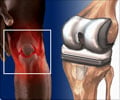A new study has found that 84 percent of male patients are still highly active 15 years after undergoing ACL knee (anterior cruciate ligament) reconstruction.
Even 15 years after undergoing ACL knee (anterior cruciate ligament) reconstruction, a new study has found that a whopping 84 percent of male patients still lead highly active lives.
Moreover, these patients, who had had reconstruction with a patellar tendon (the tendon that attaches the knee to the front of the tibia or shin bone) graft, have not developed severe osteoarthritis and their knees remain stable.The research was presented March 13 at the American Orthopaedic Society for Sports Medicine's Specialty Day in New Orleans, Louisiana.
Leo Pinczewski, corresponding author and consultant surgeon at the North Sydney Orthopaedic and Sports Medicine Centre, Wollstonecraft, Australia, said: "We have done this procedure for many years and this study looks at patients as far back as 17 years.
"The results of this technique, which was new almost 20 years ago, were excellent at five years, outstanding at 10 years and still very, very good at 15 years. Patients went back to sport quickly, had an easy rehabilitation with no brace and were frequently walking straight away."
The objective of ACL knee surgery is to stabilize the knee with a short rehabilitation letting patients get back to an active lifestyle. Long-term, the surgery aims to prevent additional damage to the knee and minimize osteoarthritis.
However, Dr. Pinczewski's success with the procedure almost didn't occur, he noted. In 1989, Dr. Pinczewski had gone to a medical seminar to hear Tom Rosenberg, of Salt Lake City, Utah, who had pioneered a surgery to arthroscopically reconstruct the ACL using the patellar tendon. Earlier, this knee surgery had been an "open" (not minimally invasive) procedure with a long rehabilitation and a high incidence of osteoarthritis. All he was able to obtain was the procedure summary from literature left at the lecture.
Advertisement
"Little did I know that I got it wrong, according to Dr. Rosenberg's method. But, in fact, it proved to be fortuitous. The way I performed the surgery was to drill the hole into the femoral bone before drilling into the tibia. Dr. Rosenberg's technique drilled into the tibia first. It turned out you can get the graft into a better position and a more stable knee if you drill in that order. I didn't know I had it 'wrong' until after I'd performed hundreds of successful operations."
Eighty-four percent of males and 45 percent of females were participating in very strenuous activities such as soccer and basketball or in strenuous activities such as skiing or tennis. Twenty-four percent of patients participated in moderate activities such as running or jogging and 14 percent participated in light activities such as walking 15 years after surgery. However, 89 percent of patients had no signs of osteoarthritis at 15 years after the surgery.
Source-ANI









